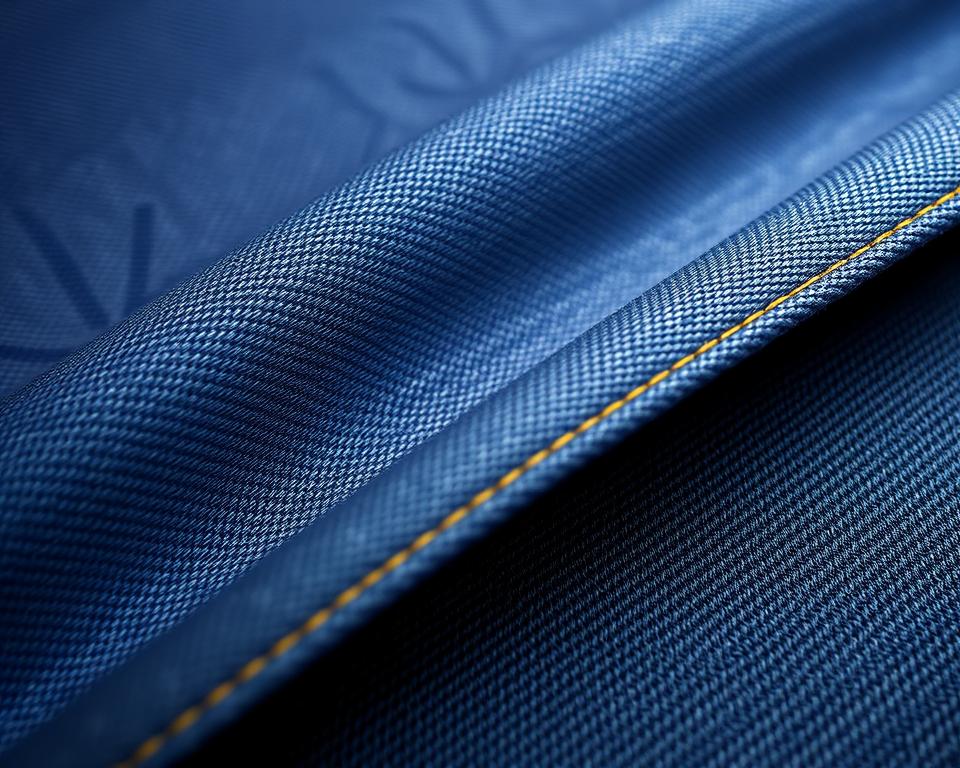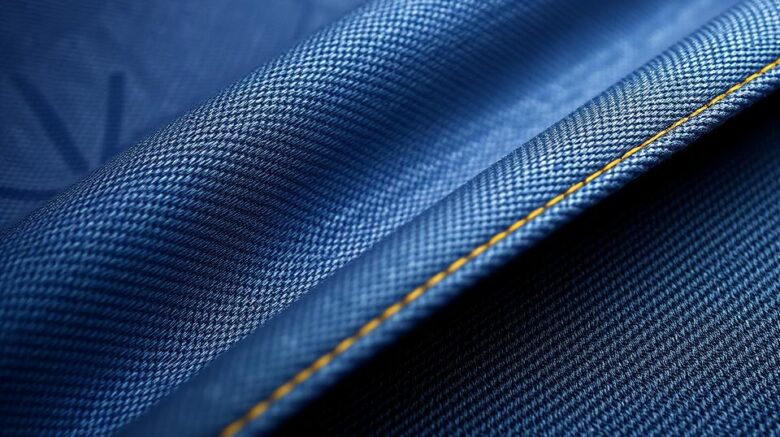A Comprehensive Handbook for High-Quality denim Selvedge Fabric
Have you ever pondered the reason some jeans feel as though they are built for endurance a lifetime? Everything revolves around the components and artistry. Consider the growing popularity of premium selvedge. This isn’t just any fabric—it exemplifies excellence and heritage.
Today, increasingly more individuals are turning to these everlasting textiles for their durability and traditional selvedge denim fabric appeal. Whether you’re a DIY sewist or a denim enthusiast, there’s something special about working with high-quality cotton and thread. It goes beyond merely constructing pants; it centers on crafting a legacy.
Within Core Fabrics, we’ve curated a collection of 14.25oz certified organic cotton and elastic options. These materials are ideal for all from raw trousers to designer jacket designs. Eager to discover the world of premium fabrics? Let’s dive in.
Defining Denim Selvedge Fabric?
What makes some trousers stand out with their distinctive, naturally edged edges? The secret is found in the selvedge denim, a superior material known for its robustness and vintage appeal. Unlike standard textiles, such material is crafted using traditional methods that have stood the test of time.
The Definition of Selvedge Denim
Selvedge denim is created via vintage shuttle looms, which yield minimal widths of about 30-35 inches. These looms weave the fabric in a way that creates self-finished borders, often marked by a characteristic red line. This process ensures the fabric is densely interlaced and highly durable.
Contemporary looms, alternatively, produce wider textile but lack the comparable degree of craftsmanship. Subtle irregularities in selvedge, like twists in the leg or irregular surfaces, are accepted as features of its character. This philosophy, termed “wabi-sabi”, exalts the beauty of inherent flaws.
The Making of Selvedge Denim
The manufacturing of selvedge denim involves a meticulous process. Shuttle looms weave the weft thread alternately, forming a thick and robust textile. This process stands in contrast with modern looms, which emphasize speed and efficiency over quality.
Labels such as Karson Denim uphold time-honored Japanese methods from the 90s. They deliberately incorporate flaws to preserve the true character of the fabric. Each piece is evaluated on a four-point system, ensuring it meets the highest standards of superiority.
| Feature | Selvedge Denim | Modern Denim |
|---|---|---|
| Span | 30-35 inches | 60+ inches |
| Construction Technique | Classic Shuttle Loom | Contemporary Loom |
| Finish | Irregular, Flawed | Even |
| Durability | High | Average |
“The allure of selvedge lies in its imperfections—every imperfection narrates a tale skill and legacy.”
The Legacy of Selvedge Denim
From humble beginnings to international fame, the story of these fabrics is rich and inspiring. What started as durable workwear in the 17th-century France has become a mark of classic elegance and excellence.
Origins in Traditional Weaving
The roots of this material dates back to Nîmes, France, where it was known as “serge de Nîmes.” Originally designed for workers, it was constructed with sturdy cotton and thread. Its resilience rendered it beloved among workers during the Gold Rush.
In the 20th century, it had become a staple for pants. The ending of the Cone Mills White Oak facility became a pivotal moment. This change paved the way for Japanese craftsmen to revive old-world weaving methods.

Modern Developments in Denim
Following WWII, Japan developed a deep appreciation for vintage American culture. Skilled workers restored classic looms to produce true reproductions. This commitment to craftsmanship guaranteed the perseverance of selvedge as a unique product.
Today, breakthroughs from Italy and Turkey have brought forth eco-friendly mixtures and stretch options. These improvements have widened the attraction of this timeless fabric. At Core Fabrics, we gather worldwide, from Montréal to Asia, to bring you the finest quality.
“The legacy of selvedge is a celebration of the enduring value of excellence and heritage.”
Why Choose Selvedge Denim?
What makes selvedge denim shine in the realm of superior textiles? Its unique qualities and exceptional longevity make it a favorite among enthusiasts and designers alike. Be it that you are crafting jeans or a sharp jacket, this fabric delivers a fusion of heritage and modern appeal.
Unique Qualities of Selvedge Fabric
Selvedge denim is renowned for its dense construction, which enhances durability and color fading characteristics. Differing from regular textiles, rainbow selvedge denim is fashioned using classic shuttle looms, yielding a more compact and exceptionally sturdy material. In doing so, it secures that every item possesses a unique texture and individuality.
Notable attributes are:
- Hairy, rigid raw denim offers a contrast to pre-washed comfort stretches.
- Through sanforization, sizes become reliable, while untreated fabrics provide a dynamic fitting process.
- Available weights span from 9.5oz Eco Finish to 14.25oz Organic, meeting diverse applications.
Sturdiness and Lifespan
One of the key attributes of selvedge denim is its longevity. The firm interlacing not only increases durability but also allows for unique fading patterns over time. This establishes it as a treasured choice for those looking for classic garments.
Main considerations:
- Mid-weight fabrics from 12oz to 14oz work well for tailored jackets and evolving jeans.
- The 14.25oz True Indigo option is highly favored for enduring jeans.
- Green alternatives, including recycled cotton with indigo blends, contribute to a sustainable collection.
Within our range at Core Fabrics, diverse choices cater to distinct demands. Spanning from raw finishes to sanforized treatments, each selection is designed for superior quality and value.
Selvedge Denim vs. Wide Denim
For making long-lasting and trendy pieces, the selection of fabric is pivotal. Among the prevalent selections are selvedge and wide denim, both offering different features. Understanding their differences can help you choose the right one for your project.
Distinct Weaving Methods
Selvedge denim is woven on time-honored shuttle looms, resulting in narrow widths of 30-35 inches. This selvedge denim jacket method generates tightly woven edges, often marked by a characteristic red line. Conversely, wide denim employs advanced projectile looms, resulting in spans of 60+ inches.
Traditional shuttle looms operate at approximately 3 meters per minute, while projectile looms can produce up to 30 meters per minute. This difference in speed impacts both the expense and the surface quality of the final product.
Advantages and Disadvantages
Selvedge denim is celebrated for its superior quality and strength. Its limited breadth suits it well for applications where visible hems or patches are desired. However, it can be pricier, averaging $23 per meter.
Wide denim is budget-friendly, ranging at $8 per half-meter. Its broader span reduces waste, ideal for large projects like furniture covering. However, it lacks the distinctive selvage detail of selvedge.
| Feature | Selvedge Denim | Wide Denim |
|---|---|---|
| Span | 30-35 inches | 60+ inches |
| Method | Shuttle Loom | Projectile Loom |
| Production Speed | 3 meters per minute | 30 meters per minute |
| Cost | $23/meter | $8 per half-meter |
When precise, structured edges are required—as in Grainline Thayer jackets—selvedge wins out. For larger projects, wide denim offers better value and efficiency. Consider your project needs to make the best decision.
Working with Selvedge Denim
Crafting with high-end textiles raises your projects to a new standard. Be it making trousers, blazers, or frocks, understanding the basics of yardage, sewing techniques, and care ensures a professional finish. We will examine the optimal use of this timeless material.
Material Requirements for Jeans and Jackets
When planning your project, calculating the right amount of material is crucial. For men’s jeans, you’ll need about 3-3.3 yards, accounting for potential defects and shrinkage. For trucker jackets, expect to use around 3.3 yards, while a skirt often needs 2 yards.
Creative pattern placement can help manage imperfections in the material. Instead of cutting around defects, consider integrating them into your design for a unique look.
| Item | Required Yardage |
|---|---|
| Male Jeans | 3 to 3.3 yards |
| Work Jacket | 3.3 yards |
| Skirt Item | 2 yards |
Tips for Sewing and Care
Using the right tools and techniques ensures a polished result. Select #70-110 needle sizes and machine attachments suitable for thick fabrics. Gütermann rPET thread works well for contrasting stitches.
Here are some additional tips:
- A tailor’s clapper helps deliver defined creases without unwanted shine.
- Our denim kits from Core Fabrics comprise topstitch thread, rivets, and 9mm jeans buttons to ensure a refined result.
- When sturdy borders are needed, such as in jackets, selvedge is optimal.
Correct care ensures your garments last longer. Use minimal washing and opt for air drying to preserve fabric quality. With these tips, your projects will stand the test of time.
To Summarize
Using superior fabrics goes beyond mere durability—it’s about instilling personality. Selvedge denim embodies this philosophy, blending artisanal charm with long-lasting quality. From jeans to tailored jackets, every stitch of this material conveys a narrative.
Core Fabrics simplifies your creative journey. Our swatch service lets you touch and test the fabric before deciding. Plus, enjoy free shipping on orders over $150 USD across North America.
Future trends in cotton textiles include sustainable blends and retro washes. These trends offer new ways to add sustainability and style to your wardrobe.
Ready to dive into the world of premium materials? Start shopping today to experience purposeful design. Your next project could be a timeless piece that lasts for years to come.
